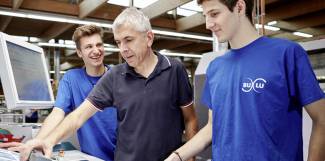Activities and Innovations to promote the Quality of Dual Education
Another part of the DuALPlus project was the collection of successful examples of innovative dual training programmes from the Alpine Space. Because of the differences in the dual education systems of the six partner countries in general and in their current states of development, the best practice examples describing renowned strategies for implementing and promoting dual education as well as concrete initiatives and programmes for dual education were included.

Key results from the best practice research within DuALPlus
The focus on best practices is different in the partner regions. Since the dual education systems in Slovenia and France are in development, the given practice examples refer more to the implementation and promotion of dual training. In France, the emphasis is also more on cooperation and axes of intervention. In Austria, Bavaria and Switzerland, there are well-established strategies of promotion of dual education and training as well as examples of successful initiatives and programmes within and beyond classical apprenticeship.
The described situation and examples of each partner region show the importance of cooperation and exchange between political and economic actors as well as municipalities, educational institutes, training companies, in-company trainers, (potential) trainees and parents. Contacts and discourses on political level should be used primarily for the implementation of innovation in education as well as the steady improvement and permeability in the education system as well as on vertical and horizontal levels.
The following list sums up the recommendations on the basis of the best practice research in the Alpine Space. They mirror the results of the SME needs analysis and evaluation of current dual education formats described in the SME needs analysis report.
- Advance the value and visibility of dual education paths as well as professional fields
- Encourage students to test their skills out as well as to learn more about different professions, materials and tools
- Enhance exchange, coordination and networking between political and economic stakeholders, SMEs, educational institutes, in-company trainers, teachers, trainees, students and parents
- Conjunction of higher education (e.g. high school diploma, university) and practical training in SMEs
- Advance special support services and educational opportunities for trainees with disadvantages
- Promote the women’s quota in training companies
- Enhance possibilities for adults and people with higher education certificates to follow a dual education and training programme
- Strengthen the support of training companies and in-company trainers concerning issues such as information, consultation, resources or advanced training

